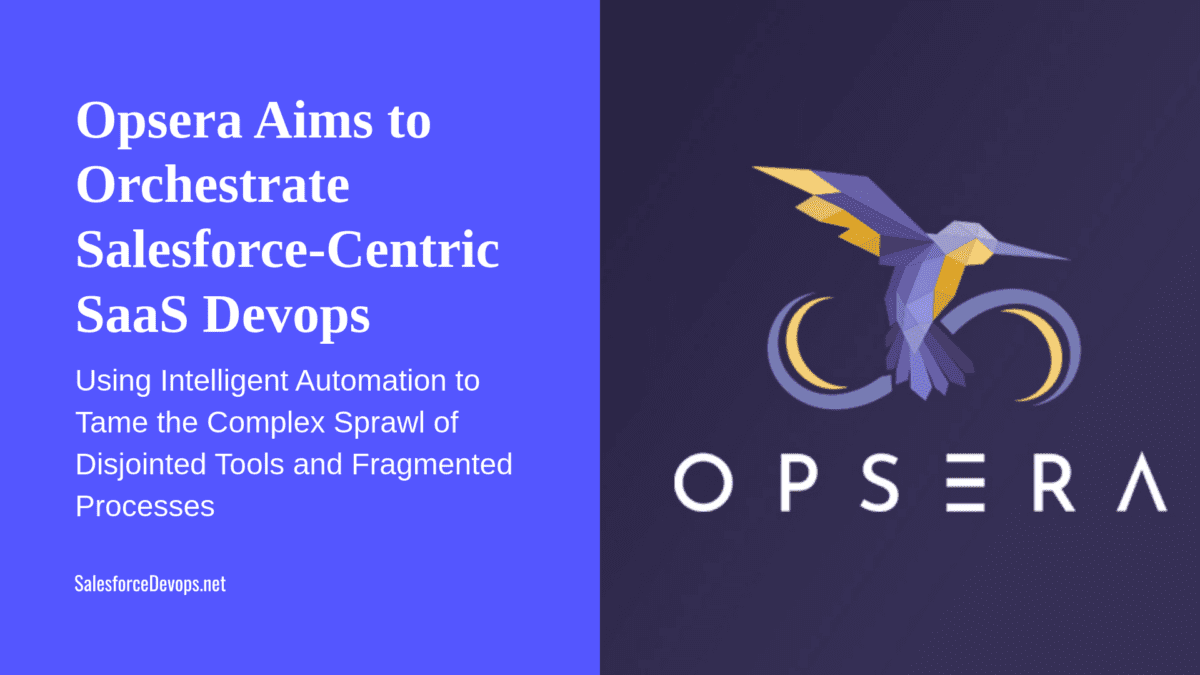Opsera Aims to Orchestrate Salesforce-Centric SaaS Devops
San Francisco-based devops platform vendor Opsera last week unveiled its latest capabilities for streamlining fragmented Salesforce development processes. The company bills itself as championing “Salesforce DevOps 3.0” with advanced orchestration features.
Opsera is among a wave of devops automation vendors targeting the complications of managing multiple SaaS applications. It currently focuses on aligning Salesforce deployments with best practices.
I spoke with co-founder and CEO Kumar Chivukula to discuss Opsera’s strategy. He described their vision for helping enterprises unify delivery pipelines across today’s complex Salesforce-centric technology stacks.
In this post I’ll analyze Opsera’s positioning and how it aims to solve Salesforce release management hurdles with intelligent orchestration.
Table of contents
The Multi-SaaS Management Struggle
Mastering Salesforce devops automation is tough. Salesforce’s declarative model combines point-and-click configuration with traditional coding. Intricate dependencies permeate orgs. Disjointed tools and processes often throttle velocity.
Yet the average company uses 17 different apps just for Salesforce development according to MuleSoft. They rely on dozens more for marketing, finance, HR and so on. Straddling these disparate SaaS systems strains IT teams.
“Unchecked SaaS sprawl creates complexity,” said Chivukula. “Disjointed tools and fragmented processes throttle delivery speed, increase risks and impede governance.”
This fragmentation contradicts the Salesforce platform’s flexibility. Integrating all these moving parts negates potential speed gains from automation. Salesforce customers I speak with consistently cite these issues as top cloud challenges.
The answer lies in unifying release coordination. Comprehensive orchestration streamlines fragmented SaaS delivery for greater reliability, visibility, and business alignment.
“To maximize SaaS ROI, leading companies are adopting unified devops platforms to streamline management,” Chivukula explained.
Opsera’s “Salesforce DevOps 3.0” Approach
Opsera launched in 2020 specifically to tackle Salesforce release complexity. It aims to be the orchestration layer that aligns declarative configuration with external toolchain automation.
The startup’s main differentiation is supporting “source-driven development.” Features like CI/CD pipelines integrate metadata deployments with version control systems and infrastructure as code tools.
“Unlike other Salesforce devops platforms, Opsera integrates with existing devops toolchains including source code management tools, git scanners, code scanners, test automation and more,” said Chivukula.
This hybrid model embraces Salesforce’s unique needs while leveraging existing investments. Opsera also provides extensive visibility into release status across teams and tools through centralized reporting.
Chivukula summarized their approach as “DevOps 3.0 for Salesforce and many other applications.” It promises faster and more scalable releases by unifying processes.
Key Opsera Capabilities
Opsera’s latest platform doubles down on analytics and integrations. New persona-based insights aim to demonstrate DevOps ROI through actionable metrics.
Expanded tool coverage includes links to repos, scanners, data migration utilities and more. The goal is compressing release steps through automation while applying governance guardrails.
Other key capabilities include:
- Declarative no-code configuration for building pipelines
- AI-driven release optimization suggestions
- Unified visibility into deployments across environments
- Automated security policy enforcement
- Salesforce metadata and source code synchronization
Opsera essentially works to align disjointed SaaS delivery with continuous integration principles. Its orchestrator plus insights provides release governance across diverse ecosystems.
“We have done integration enhancement and improvements that allow customers to increase agility, security, visibility and quality in a single, unified, orchestrated platform,” said Chivukula.
Competing in Crowded Market
Multiple DevOps automation startups target Salesforce. Incumbents like GitLab, GitHub, and Atlassian offer solutions. Niche providers like Prodly, AutoRABIT, and Gearset focus purely on Salesforce release coordination.
Opsera competes via its end-to-end, no-code approach spanning infrastructure and SaaS apps. Its specialization aims to tame Salesforce’s unique intricacies often overlooked by generalized platforms.
Customers seem to agree. Analysts forecast growing demand as more enterprises adopt DevOps in maturing Salesforce practices. Opsera claims rapid customer wins already, powering over 1.5 million deployments last year.
But the company remains in early funding stages, with around $15 million raised so far. Opsera must still build market recognition in the shadow of higher-profile competitors.
Balancing Agility and Reliability
There are clear benefits in applying orchestration to chaotic Salesforce releases. But improving speed should not come at the cost of stability.
Practitioners caution against excessive automation without sufficient guardrails. Tooling alone cannot fix misaligned processes or inadequate collaboration.
“Devops requires accompanying culture change,” Chivukula acknowledged. “Tooling alone cannot fix misaligned developer workflows or lack of cross-team collaboration.”
This aligns with my view – automation must complement expertise and organizational maturity. Opsera cannot instantly fix poor release practices through technology alone.
Salesforce’s complexity also means skills remain crucial despite abstractions like Declarative. Chivukula agreed viable adoption requires complementing automation with training and governance.
The Road Ahead
Opsera represents the new wave of SaaS devops platforms promising smarter Salesforce delivery through orchestration. Its strategy centers on alleviating integration headaches while providing guardrails.
There is clear market momentum as more enterprises buy into DevOps principles maturing cloud strategies. Opsera’s specialized Salesforce-first focus aims to take advantage of that demand.
Yet it faces stiff competition from higher-profile rivals in a fragmented space. Opsera must still demonstrate its solutions reliably drive measurable velocity, quality, and business gains.
But its vision of multi-SaaS orchestration resonates in addressing sprawl – one of organizations’ biggest cloud challenges. If Opsera can deliver cohesion across fragmented Salesforce stacks, it may help the ecosystem smoothly step into future “Salesforce 4.0” paradigms.






